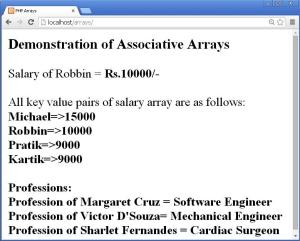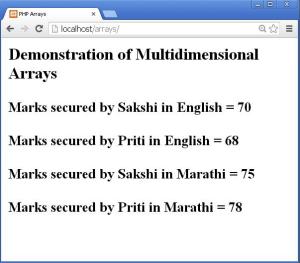Today we will learn a new concept of arrays in this PHP Arrays tutorial.
- What are arrays?
- First find an answer for the following question. What will you do if you are asked to store 4 numbers and then display them?
- The answer is very simple, you will declare 4 variables, assign values to them and then use echo() function to display them.
- Now answer the following question. What will you do if you are asked to store 400 numbers and display them at once?
- No, this is very difficult using variables because it will take a long time, memory and a lot of manual work to complete the task.
- Arrays are very useful in such situations.
- Array is a data structure that stores one or more similar type values in a single variable.
- You can use arrays when you want to store similar type values that are more in number.
- Array stores each value assigned to it at an index number starting from zero.
- I mean if we assigned values “One”, ”Two”, “Three” to an array, it will assign value “One” to the index number 0, then it will assign value “Two” to the index number 1 and value “Three” to the index number 2 and so on if more values are assigned.
- The index numbers make it easy to access the values from array.
- The values stored in arrays can also be accessed at once using a loop. Mostly for loop is used for the same.
- In PHP we have three types of arrays:
- Numeric Arrays
- Associative Arrays
- Multidimensional Arrays
- Let us have a look on each type of array:
- Types of Array:
- Numeric Arrays:
- Numeric arrays are simple arrays with a numeric index.
- These arrays are also called as indexed arrays.
- The values stored in it are accessed in linear fashion.
- These arrays can store any type of values i.e. strings, integers, floats, objects but their indexes are always integer numbers.
- By default the index in arrays start with zero (0).
- These arrays are created using array() function.
- Syntax of creating an array:
- Example for it is shown below:
- In the above example we have created an array of flowers.
- In this array the values “Rose”, “Mogra” and “Merrygold” will be given indexes 0, 1 and 2 respectively.
- These values can be accessed when needed using the name of array and index of the particular value, like “Rose” can be accessed using $flowers[0], “Merrygold” can be accessed using $flowers[2] and “Mogra” can be accessed using $flowers[1].
- For accessing values from array the indexes are written in square brackets.
- If we want to access all the values at once we can use loops.
- There is another method to create an array as shown below:
- The array $flowers can also be created using the above shown method, by manually assigning values to the indexes of the array.
- Let us see an example to demonstrate an Indexed array:
- To demonstrate it, we need to create a new folder named arrays in the htdocs folder in xampp folder located in C drive. Then open a new notepad++ document and save it as index.php in the newly created arrays folder.
- Write the following code in index.php file:
- In the above code, we have used 2 methods to create array.
- These array elements can be accessed individually as well as in loops as shown above.
- The first element of $nos array can be accessed as $nos[0] and so on.
- The output is shown below:
Variable_name=array(value1, value2, value3,…);
$flowers=array(“Rose”,”Mogra”,”Merrygold”);
$flowers[0]=”Rose”; $flowers[1]=”Mogra”; $flowers[2]=”Merrygold”;
<html>
<head>
<title>PHP Arrays</title>
</head>
<body>
<h3>Demonstration of Indexed Arrays</h3>
<?php
//first method of creating indexed array
$nos=array(10,20,30,40,50);
echo "<br><strong>Numbers in nos array are:</strong><br>";
//using for loop to access all the values of array at once
for($i=0;$i<5;$i++)
{
echo "<strong>".$nos[$i]."</strong><br>";
}
//another method of creating indexed array
$prod[0]="UPS";
$prod[1]="Keyboard";
$prod[2]="Mouse";
echo "<br><br><strong>Products in prod array are:</strong><br>";
//we can also use foreach loop to access all the values of array at once
foreach($prod as $x)
{
echo "<strong>".$x."</strong> <br>";
}
?>
</body>
</html>
- The associative arrays are very similar to indexed arrays with respect to their function but they use strings as index and not numbers.
- These strings that are used for indexing in associative arrays are called keys.
- The keys and values associated with it are given during the creation of the array.
- Syntax of associative array is given below:
Variable_name=array(“key1”=>value1,”key2”=>value2,”key3”=>value3,…);
$marks=array(“Amol”=>80,”Rahul”=>78,”Rohan”=>68);
$marks[‘Amol’]=80; $marks[‘Rahul’]=78; $marks[‘Rohan’]=68;
<html>
<head>
<title>PHP Arrays</title>
</head>
<body>
<h3>Demonstration of Associative Arrays</h3>
<?php
//first method of creating associative array
$salary=array("Michael"=>15000,"Robbin"=>10000,"Pratik"=>9000,"Kartik"=>9000);
echo "Salary of Robbin = <strong>Rs.".$salary["Robbin"]."/-</strong><br><br>";
//displaying all key=>value pairs using foreach loop
echo "All key value pairs of salary array are as follows:<br>";
foreach($salary as $s=>$s_value)
{
echo "<strong>".$s."=>".$s_value."</strong><br>";
}
//another method of creating associative array
$profession['Margaret Cruz']="Software Engineer";
$profession['Victor Dsouza']="Mechanical Engineer";
$profession['Sharlet Fernandes']="Cardiac Surgeon";
//displaying values in array profession
echo "<br><strong>Professions:</strong><br>";
echo "<strong>Profession of Margaret Cruz = ".$profession['Margaret Cruz']."</strong><br>";
echo "<strong>Profession of Victor D'Souza= ".$profession["Victor Dsouza"]."</strong><br>";
echo "<strong>Profession of Sharlet Fernandes = ".$profession['Sharlet Fernandes']."</strong>";
?>
</body>
</html>
echo "Salary of Robbin = <strong>Rs.".$salary["Robbin"]."/-</strong><br><br>";
foreach($salary as $s=>$s_value)
{
echo "<strong>".$s."=>".$s_value."</strong><br>";
}
- In PHP, multidimensional arrays are the arrays that contain one or more arrays in it and values in these arrays are accessed using multiple indexes.
- In these multidimensional arrays an element ( the values of array are also called as elements) in the main array can be an array and element in the sub-array can also be an array and so on. Thus multidimensional array is a collection of small arrays.
- Example of multidimensional array is shown below:
$products=array(
“Cloths”=>array(
“Kids wear”=>array(frock,
jeans,
shirts,
t-shirts)),
“Ladies wear”,
“Gents wear”
),
"Stationary”=>array(
"Notebook”=>25,
“Pen”=>20,
“Pencil”=>5
),
“Miscellaneous”=>array(
“CD”=>10,
“DVD”=>16
)
);
$products[‘Stationary’][‘Notebook’];
<html>
<head>
<title>PHP Arrays</title>
</head>
<body>
<h3>Demonstration of Multidimensional Arrays</h3>
<?php
//creating multidimentional array
$marks=array("Sakshi"=>array("Hindi"=>78,"Marathi"=>75,"English"=>70),"Priti"=>array("Hindi"=>80,"Marathi"=>78,"English"=>68));
echo "<strong>Marks secured by Sakshi in English = ".$marks['Sakshi']['English']."</strong><br><br>";
echo "<strong>Marks secured by Priti in English = ".$marks['Priti']['English']."</strong><br><br>";
echo "<strong>Marks secured by Sakshi in Marathi = ".$marks['Sakshi']['Marathi']."</strong><br><br>";
echo "<strong>Marks secured by Priti in Marathi = ".$marks['Priti']['Marathi']."</strong><br><br>";
?>
</body>
</html>
Thus we learned the basics of arrays in this PHP Arrays tutorial.






